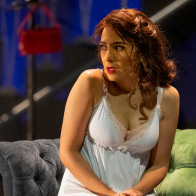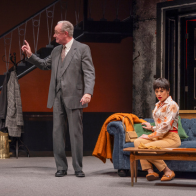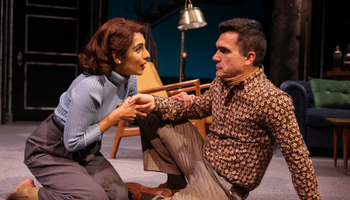
Review: DIAL M FOR MURDER at Arizona Theatre Company
By Herbert Paine. Originally published on BroadwayWorld.com
Confession: This theatre critic is an unabashed fan of Jeffrey Hatcher. His prowess as a prolific and imaginative playwright shines through his ingenious adaptations of classics like Dr. Jekyll and Mr. Hyde, The Turn of the Screw, and his original Sherlock Holmes stories, including Holmes and Watson and Sherlock Holmes and the Adventure of the Suicide Club, both of which premiered at Arizona Theatre Company. While he’s now celebrating the praise of his latest bit of Sherlockian fiction, Holmes/Poirot (on stage at Minnesota’s Park Square Theatre through November 3rd) his 2022 adaptation of Dial M For Murder is getting the royal treatment at…where else but…ATC.
Hatcher’s new take on Dial M For Murder brings fresh energy to Frederick Knott’s classic thriller, giving it a bit of a facelift for modern audiences. If you’re familiar with the famous 1954 Hitchcock thriller with Ray Milland and Grace Kelly (the film was preceded by the premiere of the play two years earlier on BBC television), rest assured that the basics are still here ~ but with some novel twists and tweaks.
In this version, Tony Wendice (Dan Domingues, embodying the archetypal charming sociopath) plots to bump off his rich wife Margot (Awesta Zarif) because he’s jealous over her affair with mystery writer Maxine (Lucy Lavely) whose new novel, by the way, he is promoting. Greed follows jealousy as Tony engages ~ rather, blackmails ~ Lesgate (Aaron Cammack) an old school acquaintance with a felonious past to do the deed. Tony has devised an intricate plot ~ the key to which is a key ~ but, things don’t go as planned. Tony scrambles to cover his tracks, weaving together a tangled web of lies, but it takes a tenacious inspector, Hubbard’s the name, (Peter Howard) to pull the rug out from under Tony’s plot.



It’s classic suspense, and director Michael John Garcés has seen to it that the performances of the leads are on point, backed by a clever mix of Tom Ontiveros’s noirish lighting, Daniel Perelstein Jaquette’s dramatic sound effects, and James Noone’s sophisticated set design.
The play thrives on a tightrope walk between suspense and dark humor, and when done right, it’s pretty gripping. To that end, this creative collaboration has evoked a mood and atmosphere that heightens the tensions of the play…most of the time. However, if you’re a fan of fast-paced and tightly wound productions, you might find that this one slows down now and then and loses a bit of its edge when, in a campy homage to early filmdom, pregnant and reflective pauses last just a few seconds too long.
One of Hatcher’s key updates is the portrayals of the female characters and their nuanced relationship. Zarif and Lavely effectively represent their characters as empowered women who are wise to the machinations of the men around them. They play off one another brilliantly. One of the results is that Maxine is a more substantial character who shifts from a conventional love interest into someone who actively challenges Tony’s manipulations and becomes a significant player in the unfolding drama. Kudos to Hatcher for giving both characters a stronger voice and a more active role in shaping the narrative.


By doing so, Tony becomes a much better defined, if not necessarily admirable, character. His suave exterior cracks under pressure, revealing deeper layers of narcissism and desperation, which make for a gripping performance. Domingues captures the duality of Tony’s charm and menace in moments of vulnerability and moral ambiguity that make him less of a one-dimensional villain and more of a tragic figure undone by his own hubris.
The dialogue also gets a healthy dose of refresh from the originals. It’s sharper and snappier, with some dark humor mixed in that keeps things lively without losing the suspense. Hatcher’s updates are subtle enough that it doesn’t feel like he’s trying too hard to modernize the language, but there’s a definite energy here that’s more in tune with how people actually talk today. Plus, the pacing has been tightened up to keep the tension building, which helps the play feel less like an old-school whodunit and more like a high-stakes psychological showdown.
All in all, Hatcher’s Dial M For Murder doesn’t stray far from the suspenseful roots that made it famous, but the updates breathe new life into the story. The modern touches, solid performances by the cast, and smart dialogue bring it into the present while still keeping that classic vibe. It’s a great mix of old and new, and it’s clear why this play has staying power.
So, if you’re in the mood for a suspenseful time at the theater, give Dial M For Murder a shot.